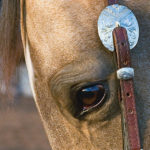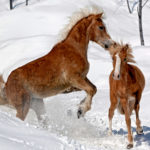Horse camping allows you to ride on trails in areas you’ve always dreamed about. Everyone – regardless of age, physical condition, or finances – can camp. It doesn’t require pack stock or equipment. You simply select a site, set up a camp, then saddle your equine friend and hit the trails.

On your own horse, you’ll be able to access thousands of miles of trails, from oceans to lakeshores, mountain meadows to desert sands, local open space to wilderness. All you need for a safe and fun adventure is the ability to get there, and the know-how to plan ahead. Here are some tips to get you started.
Find Time
If you work fulltime, plan to camp on the weekends, long holiday weekends, or during your vacation time. For short trips, select?a horse camp close to home. Hauling 500 miles to camp for a few hours is stressful for both you and your horse. You’ll spend more time on the road than on the trail. Save long trips for an extended four-day weekend or longer.
When choosing when and where to go, consider the time of year. Camping in high altitudes in November can mean snow.?Desert camping in July can mean 100-plus-degree heat. Two or three days before leaving, contact the agency in charge of the camp, and ask about the weather and any “temporary regulations” (seasonal restrictions).
Also check moon phases. It’s nice to camp under a full moon the first couple nights. Moonlight will allow your horse to see better in a strange environment. He may be used to a barn light at home, so complete darkness can be unnerving. During a full moon, it’s also easier to check on your horse as he moves around the corral.
Select a Camp Type
When deciding where to camp, first consider how much camping experience both you and your horse have had. Camping can be hard on you both. This is especially true the first few times, but even seasoned campers experience some stress. (Of course, the payoff is worth it.) Keep in mind that your horse might’ve lived most of his life in a barn. Or, he might live in a pasture but has never seen a pine tree or a deer.
Just like hotels, horse camps come with a variety of amenities. Essentially, they can be divided into three categories: “five-star”; developed; and primitive. Here’s a rundown of each one.
“Five-star”: This type of camp is usually private, or developed and maintained by a local riding club. It offers such amenities as corrals,?covered shelters, hot-water showers, flush toilets, wash racks, picnic tables, and recreational-vehicle hookups. This type of camp is recommended for your first camping experience, to enhance your enjoyment and reduce stress. Fees for this type of camp range from a few dollars to $50 or more per night.
One “five-star” camp is Jack Brooks Horse Camp in the San Francisco Bay area. It not only offers corrals, wash racks, hot showers, and electricity, but also equipment for cleaning paddocks and a complete cooking area, with griddles, hot plates, fire pits, and tables on green grass. If you’d rather not cook, area restaurants will deliver everything from pizza to complete dinners. There’s also a feed store nearby. Wandering wildlife is usually limited to deer, raccoons, and low-impact critters.
Developed: You’ll find developed camps on public lands, but some are privately run. Here, you might find a corral, a toilet (usually pit), a couple picnic tables, and a fire ring. Some don’t have corrals, so your horse will have to be high lined, picketed, tied to a trailer, or contained in some way.?A developed horse camp is great after you have a couple trips under the trailer tires and wish to move into more pristine territory. Fees range from free to a minimal cost.
Primitive: In this type of camp, you’ll find no amenities; there’s simply nothing there. The federal government owns the largest amount of primitive lands; of this land, the National Forest Service and Bureau of Land Management own the greatest percentage. You can camp anywhere on NFS or BLM land unless posted otherwise, accessing areas where few people wander.
For primitive camping, you’ll pack everything you need into your trailer and tow vehicle. Then you’ll simply head down a dirt road, find a nice setting, and set up camp. You’ll need to know basic survival techniques. In remote areas, you may not see another human being for days or weeks on end. I’ve camped for up to six weeks in primitive camps and never saw another person. It was just me, my horse, and Mother Nature!
Pick Your Spot
To locate horse camps, read guidebooks, trail-riding magazines, and other publications. Talk to other horse owners and to equine organizations.
Note that almost all federal lands have horse camps and trails. Contact the regional offices in the area you’d like to go, and ask about horse camping. Check the phone book for federal listings. Many state parks and forests also have horse camps; contact state officials, and ask for a state-parks map showing trails and horse camps. Or, contact the parks directly.
You can find private horse camps in travel directories and, of course, the phone book. An Internet search will also bring up federal and state agencies, plus private horse camps. (Tip: Set aside a few hours for online searches; you might have to follow several links, and the vast quantity of information can be distracting. One good place to start is www.horseandmuletrails.com.)
Gather information, make a list of likely camps, then narrow down your choices. Consider each camp’s location. What are the roads like? Are you prepared to drive on rugged, unpaved roads? What about one-lane roads with turnouts? Consider the size of your trailer and tow-vehicle. Often, a small, two-horse trailer will allow you to access remote areas better than a larger one.
As mentioned earlier, choose a camp that matches your camping abilities. Your first horse-camping adventure will determine whether you’ll ever want to camp again. Keep those first few trips simple, easy, and fun. Then decide whether you’d like to progress to camp with fewer amenities.
Here are the lists I use when I go horse camping. You may customize them to suit your own camping needs.
Horsekeeping
Baling wire
Brushes/curries
Burlap bags
Coffee can
Feed/forage
Folding rack
Funnel
Grain (measured)
Grain bags
Grain pans/tubs
Hay hooks
Hay nets
Hoof conditioner
Hoof pick/cleaning tools
Horse blankets (summer/winter)
Horseshoes/nails
Insect repellent (equine)
Block or loose salt/minerals
Manure rack
Supplements/bran
Water
Water buckets/pails
Water cans
Horse-Health
Aspirin (equine)
Cold packs
First-aid kit
Bandages/wraps
Prescription drugs/medications
Horse-Camping
Broom
Corral tape
Duct tape
Flashlight
Garbage bags
Halters
Hammer/nails
High-line rope
High-line lead ropes
Knot eliminators
Lead ropes/extra rope
Portable corral
Shovel
Tree-savers
Riding-Related
Bit/extra bit
Breastcollar/crupper
Bridle/extra bridle
Leather cleaner
Leather sewing kit
Rags
Saddles
Saddle pads





